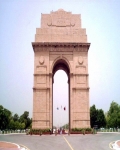India Gate
Archaeology »
Archaeological Monuments » India Gate
India Gate - India
India Gate is located in Rajpath,Delhi.
India Gate monument was established on 1921.
Primary threats to India Gate :
India Gate is constructed as a memorial and was built in the memory of 90, 00 soldiers who laid down their lives during World War I.
Historical facts of India Gate :
- India Gate is one of the most iconic and significant monuments in New Delhi, India. It is a war memorial that stands as a symbol of national pride and sacrifice. Built-in 1931, India Gate holds historical and cultural importance, serving as a commemoration of the Indian soldiers who lost their lives in various conflicts.
- The foundation stone for India Gate was laid in 1921 by the Duke of Connaught, Prince Arthur, during the British colonial period. The monument was designed by Sir Edwin Lutyens, a renowned architect who played a key role in designing many structures in New Delhi. The construction was completed in 1931, and it was originally known as the All India War Memorial.
- The design of India Gate draws inspiration from the Arc de Triomphe in Paris. It is a triumphal arch made of sandstone and stands at a height of 42 meters. The arch is adorned with intricate carvings and inscriptions, including the names of over 13,000 British and Indian soldiers who sacrificed their lives during World War I.
- India Gate serves as a memorial for the soldiers of the Indian Army who lost their lives in various conflicts, including World War I and the Third Anglo-Afghan War. The monument pays tribute to their bravery, valor, and selflessness in defending the nation and its ideals. It stands as a reminder of the sacrifices made by countless individuals in the service of their country.
- The Amar Jawan Jyoti, or the Flame of the Immortal Soldier, is an eternal flame that burns beneath the arch of India Gate. It was added after India's independence in 1947 and serves as a symbol of remembrance for all the soldiers who have laid down their lives for the country. The flame is kept perpetually lit and is guarded by soldiers of the Indian Armed Forces.
- India Gate has been a venue for important national events and ceremonies. It serves as a focal point for the Republic Day Parade held annually on January 26th, where the President of India hoists the national flag and pays homage to the soldiers. The monument attracts a large number of visitors throughout the year, who come to pay their respects and enjoy the serene surroundings.
- Over the years, India Gate has become a popular recreational spot for both locals and tourists. The expansive lawns surrounding the monument provide a peaceful setting for picnics, leisurely walks, and various outdoor activities. The area comes alive with street vendors, food stalls, and cultural performances, creating a vibrant atmosphere.
- India Gate has stood witness to significant historical events and social gatherings. It has been a site for public demonstrations, political rallies, and celebrations of national achievements. The monument has become deeply ingrained in the cultural fabric of India, symbolizing the unity, courage, and indomitable spirit of the nation.
- In conclusion, India Gate in New Delhi is a historically significant monument that pays tribute to the Indian soldiers who sacrificed their lives in various conflicts. Built-in 1931, it stands as a symbol of national pride and remembrance. With its architectural grandeur, the eternal flame, and its role in hosting important national events, India Gate holds a special place in the hearts of Indians and serves as a reminder of the sacrifices made by the brave soldiers of the country.

